
Philosophy in the Flesh
Philosophy in
the Flesh
THE EMBODIED MIND AND
ITS CHALLENGE TO
WESTERN THOUGHT
George Lakoff and Mark Johnson



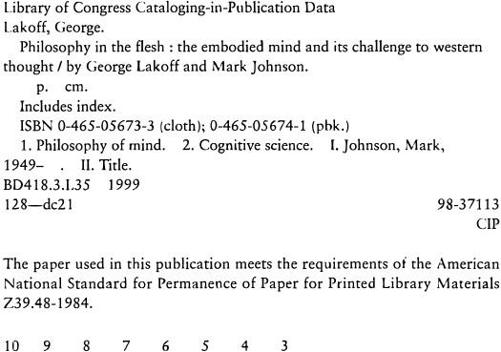
For Three generations of Lakoffs Herman, Sandy, and Andy
and for Sandra McMorris Johnson
Contents
ix
XIII
Part I
HOW THE EMBODIED MIND CHALLENGES THE WESTERN PHILOSOPHICAL TRADITION
Part II
THE COGNITIVE SCIENCE OF BASIC PHILOSOPHICAL IDEAS
Part It t
THE COGNITIVE SCIENCE OF PHILOSOPHY
Part IV
EMBODIED PHILOSOPHY
Acknowledgments

n undertaking of this scope would not be possible without a great deal of help. Our students and colleagues at Berkeley and at Oregon L have contributed immeasurably to this work, and we would like to thank them, as well as other friends who have gone out of their way to help in this enterprise.Claudia Baracchi, Thomas Alexander, David Barton, and Robert Hahn helped us greatly to appreciate the subtleties of Greek philosophy and provided valuable assistance with Chapters 16, 17, and 18.Rick Grush, Michele Emanatian, and Tim Rohrer read and gave extensive comments on various drafts of the manuscript as a whole.Eve Sweetser was involved in the project from the beginning and has made innumerable suggestions and contributions over the years. Her groundbreaking research on the metaphors for mind laid the foundation for the study presented in Chapter 12.Jerome Feldman's definitive contributions to the neural theory of language helped lay the foundations for the approach to the embodiment of mind that is central to this work. In addition, we have benefited immensely from his detailed suggestions on various drafts of the manuscript.Robert Powell went above and beyond the call of collegiality and friendship in helping to work out the mathematical details of rational action in Chapter 23.Joseph Grady's investigations into the experiential basis of metaphor played a major role in the theory presented in this book, as did Srini Narayanan's neural theory of metaphor, which meshed perfectly with Grady's results.Jane Espenson spent more than a year researching the metaphorical structure of causation before leaving Berkeley for a writing career in Hollywood.None of this work would have been possible without the development of cognitive linguistics as a discipline. Our debt to those who have defined the discipline is both immense and evident throughout the entire project. In particular, our gratitude goes to Ron Langacker, Leonard Talmy, Gilles Fauconnier, Eve Sweetser, Charles Fillmore, Mark Turner, Claudia Brugman, Adele Goldberg, and Alan Cienki.We owe a special debt to Evan Thompson, Francisco Varela, and Eleanor Rosch, whose extensive work on embodied cognition has been inspirational and has informed our thinking throughout.In addition, many students and colleagues have made analytic suggestions and contributed unpublished research that has greatly enriched this work. We would like to recognize their contributions, chapter by chapter.Chapter 3, The Embodied Mind and Appendix: Jerome Feldman, Terry Regier, David Bailey, and Srini Narayanan.Chapter 10, Time: Rafael Nunez, Kevin Moore, Jeong-Woon Park, Mark Turner, and John Robert Ross.Chapter 11, Events and Causes: Jane Espenson, Karin Myhre, Sharon Fischlet, Claudia Brugman, Adele Goldberg, Sarah Taub, and Tim Rohrer.Chapter 12, The Mind: Eve Sweetser, Alan Schwartz, Michele Emanatian, and Gyorgy Laszlo.Chapter 13, The Self: Miles Becker, Andrew Lakoff, Yukio Hirose, and Bart Wisialowski.Chapter 14, Morality: Bruce Buchanan, Sarah Taub, Chris Klingehiel, and Tim Adamson.We also extend our deepest thanks to others who have helped in various ways: Robert Adcock, David Abram, Michael Barzelay, David Collier, Owen Flanagan, David Galin, Christopher Johnson, Dan Jurafsky, Jean-Pierre Koenig, Tony Leiserowitz, Robert McCauley, James D. McCawley, Laura Michaelis, Pamela Morgan, Charlene Spretnak, and Lionel Wee. We would also like to thank all the participants in seminars we have held on philosophy and cognitive science at Berkeley and at Oregon, as well as the participants in our seminar at the 1996 Berkeley Summer Institute. We are indebted to several anonymous readers whose comments made this a much better book.We are especially grateful for the diligent copyediting of Ann Moru and the editorial guidance of William Frucht.Our wives, Kathleen Frumkin and Sandi Johnson, have not only provided support above and beyond the call of duty with their love and abundant pa tience extending over many years, but have also given us regular and invaluable feedback on our ideas.We would especially like to express our gratitude for the privilege of working in the extraordinary intellectual communities at the University of California at Berkeley and the University of Oregon at Eugene. We owe a particular debt to the Institute for Cognitive Studies and the International Computer Science Institute at Berkeley.Finally, we want to honor the two greatest philosophers of the embodied mind. Any book with the words "philosophy" and "flesh" in the title must express its obvious debt to Maurice Merleau-Ponty. He used the word "flesh" for our primordial embodied experience and sought to focus the attention of philosophy on what he called "the flesh of the world," the world as we feel it by living in it. John Dewey, no less than Merleau-Ponty, saw that our bodily experience is the primal basis for everything we can mean, think, know, and communicate. He understood the full richness, complexity, and philosophical importance of bodily experience. For their day, Dewey and Merleau-Ponty were models of what we will refer to as "empirically responsible philosophers." They drew upon the best available empirical psychology, physiology, and neuroscience to shape their philosophical thinking.
A Note on the References

n citing the many sources we used in preparing this book, we have departed somewhat from the familiar author-date reference system by arranging the sources into subject categories. Each citation begins with a capitalized letter and a number (or sometimes just a letter) keyed to its location in the reference list. For example, our book Metaphors We Live By is cited in the text as (Al, Lakoff and Johnson 1980). This tells readers that the full listing can be found in section Al of the references, "Metaphor Theory." We have done this to make it easier to find specific references and also to provide a helpful start for readers who want to dig deeper into the literature on particular topics.Here is a complete list of the subject categories:A. Cognitive Science and Cognitive LinguisticsA 1. Metaphor TheoryA2. Experimental Studies in MetaphorA3. Metaphor in Gesture and American Sign LanguageA4. CategorizationAS. ColorA6. FramingA7. Mental Spaces and Conceptual BlendingA8. Cognitive Grammar and Image SchemasA9. Discourse and PragmaticsA10. Decision Theory: The Heuristics and Biases ApproachB. Neuroscience and Neural ModelingB1. Basic NeuroscienceB2. Structured Connectionist ModelingC. PhilosophyC1. Cognitive Science and Moral PhilosophyC2. Philosophical SourcesD. Other LinguisticsE. Miscellaneous
Next page



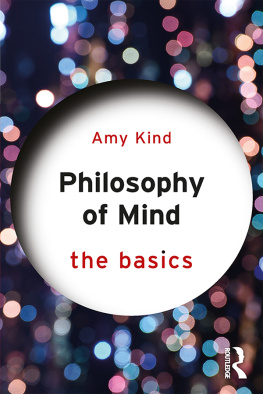


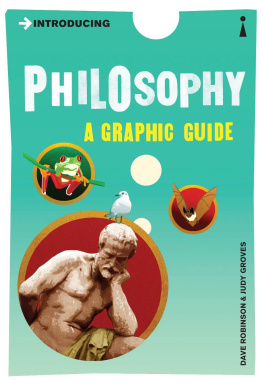
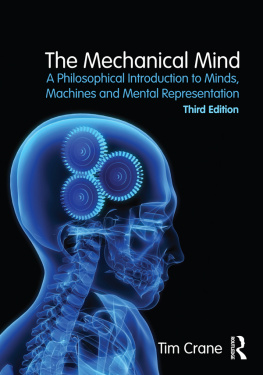
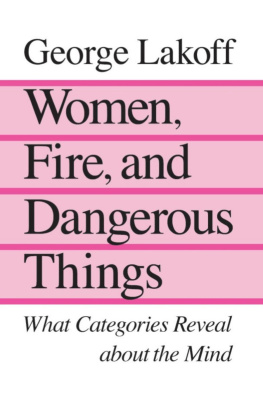






 n undertaking of this scope would not be possible without a great deal of help. Our students and colleagues at Berkeley and at Oregon L have contributed immeasurably to this work, and we would like to thank them, as well as other friends who have gone out of their way to help in this enterprise.Claudia Baracchi, Thomas Alexander, David Barton, and Robert Hahn helped us greatly to appreciate the subtleties of Greek philosophy and provided valuable assistance with Chapters 16, 17, and 18.Rick Grush, Michele Emanatian, and Tim Rohrer read and gave extensive comments on various drafts of the manuscript as a whole.Eve Sweetser was involved in the project from the beginning and has made innumerable suggestions and contributions over the years. Her groundbreaking research on the metaphors for mind laid the foundation for the study presented in Chapter 12.Jerome Feldman's definitive contributions to the neural theory of language helped lay the foundations for the approach to the embodiment of mind that is central to this work. In addition, we have benefited immensely from his detailed suggestions on various drafts of the manuscript.Robert Powell went above and beyond the call of collegiality and friendship in helping to work out the mathematical details of rational action in Chapter 23.Joseph Grady's investigations into the experiential basis of metaphor played a major role in the theory presented in this book, as did Srini Narayanan's neural theory of metaphor, which meshed perfectly with Grady's results.Jane Espenson spent more than a year researching the metaphorical structure of causation before leaving Berkeley for a writing career in Hollywood.None of this work would have been possible without the development of cognitive linguistics as a discipline. Our debt to those who have defined the discipline is both immense and evident throughout the entire project. In particular, our gratitude goes to Ron Langacker, Leonard Talmy, Gilles Fauconnier, Eve Sweetser, Charles Fillmore, Mark Turner, Claudia Brugman, Adele Goldberg, and Alan Cienki.We owe a special debt to Evan Thompson, Francisco Varela, and Eleanor Rosch, whose extensive work on embodied cognition has been inspirational and has informed our thinking throughout.In addition, many students and colleagues have made analytic suggestions and contributed unpublished research that has greatly enriched this work. We would like to recognize their contributions, chapter by chapter.Chapter 3, The Embodied Mind and Appendix: Jerome Feldman, Terry Regier, David Bailey, and Srini Narayanan.Chapter 10, Time: Rafael Nunez, Kevin Moore, Jeong-Woon Park, Mark Turner, and John Robert Ross.Chapter 11, Events and Causes: Jane Espenson, Karin Myhre, Sharon Fischlet, Claudia Brugman, Adele Goldberg, Sarah Taub, and Tim Rohrer.Chapter 12, The Mind: Eve Sweetser, Alan Schwartz, Michele Emanatian, and Gyorgy Laszlo.Chapter 13, The Self: Miles Becker, Andrew Lakoff, Yukio Hirose, and Bart Wisialowski.Chapter 14, Morality: Bruce Buchanan, Sarah Taub, Chris Klingehiel, and Tim Adamson.We also extend our deepest thanks to others who have helped in various ways: Robert Adcock, David Abram, Michael Barzelay, David Collier, Owen Flanagan, David Galin, Christopher Johnson, Dan Jurafsky, Jean-Pierre Koenig, Tony Leiserowitz, Robert McCauley, James D. McCawley, Laura Michaelis, Pamela Morgan, Charlene Spretnak, and Lionel Wee. We would also like to thank all the participants in seminars we have held on philosophy and cognitive science at Berkeley and at Oregon, as well as the participants in our seminar at the 1996 Berkeley Summer Institute. We are indebted to several anonymous readers whose comments made this a much better book.We are especially grateful for the diligent copyediting of Ann Moru and the editorial guidance of William Frucht.Our wives, Kathleen Frumkin and Sandi Johnson, have not only provided support above and beyond the call of duty with their love and abundant pa tience extending over many years, but have also given us regular and invaluable feedback on our ideas.We would especially like to express our gratitude for the privilege of working in the extraordinary intellectual communities at the University of California at Berkeley and the University of Oregon at Eugene. We owe a particular debt to the Institute for Cognitive Studies and the International Computer Science Institute at Berkeley.Finally, we want to honor the two greatest philosophers of the embodied mind. Any book with the words "philosophy" and "flesh" in the title must express its obvious debt to Maurice Merleau-Ponty. He used the word "flesh" for our primordial embodied experience and sought to focus the attention of philosophy on what he called "the flesh of the world," the world as we feel it by living in it. John Dewey, no less than Merleau-Ponty, saw that our bodily experience is the primal basis for everything we can mean, think, know, and communicate. He understood the full richness, complexity, and philosophical importance of bodily experience. For their day, Dewey and Merleau-Ponty were models of what we will refer to as "empirically responsible philosophers." They drew upon the best available empirical psychology, physiology, and neuroscience to shape their philosophical thinking.
n undertaking of this scope would not be possible without a great deal of help. Our students and colleagues at Berkeley and at Oregon L have contributed immeasurably to this work, and we would like to thank them, as well as other friends who have gone out of their way to help in this enterprise.Claudia Baracchi, Thomas Alexander, David Barton, and Robert Hahn helped us greatly to appreciate the subtleties of Greek philosophy and provided valuable assistance with Chapters 16, 17, and 18.Rick Grush, Michele Emanatian, and Tim Rohrer read and gave extensive comments on various drafts of the manuscript as a whole.Eve Sweetser was involved in the project from the beginning and has made innumerable suggestions and contributions over the years. Her groundbreaking research on the metaphors for mind laid the foundation for the study presented in Chapter 12.Jerome Feldman's definitive contributions to the neural theory of language helped lay the foundations for the approach to the embodiment of mind that is central to this work. In addition, we have benefited immensely from his detailed suggestions on various drafts of the manuscript.Robert Powell went above and beyond the call of collegiality and friendship in helping to work out the mathematical details of rational action in Chapter 23.Joseph Grady's investigations into the experiential basis of metaphor played a major role in the theory presented in this book, as did Srini Narayanan's neural theory of metaphor, which meshed perfectly with Grady's results.Jane Espenson spent more than a year researching the metaphorical structure of causation before leaving Berkeley for a writing career in Hollywood.None of this work would have been possible without the development of cognitive linguistics as a discipline. Our debt to those who have defined the discipline is both immense and evident throughout the entire project. In particular, our gratitude goes to Ron Langacker, Leonard Talmy, Gilles Fauconnier, Eve Sweetser, Charles Fillmore, Mark Turner, Claudia Brugman, Adele Goldberg, and Alan Cienki.We owe a special debt to Evan Thompson, Francisco Varela, and Eleanor Rosch, whose extensive work on embodied cognition has been inspirational and has informed our thinking throughout.In addition, many students and colleagues have made analytic suggestions and contributed unpublished research that has greatly enriched this work. We would like to recognize their contributions, chapter by chapter.Chapter 3, The Embodied Mind and Appendix: Jerome Feldman, Terry Regier, David Bailey, and Srini Narayanan.Chapter 10, Time: Rafael Nunez, Kevin Moore, Jeong-Woon Park, Mark Turner, and John Robert Ross.Chapter 11, Events and Causes: Jane Espenson, Karin Myhre, Sharon Fischlet, Claudia Brugman, Adele Goldberg, Sarah Taub, and Tim Rohrer.Chapter 12, The Mind: Eve Sweetser, Alan Schwartz, Michele Emanatian, and Gyorgy Laszlo.Chapter 13, The Self: Miles Becker, Andrew Lakoff, Yukio Hirose, and Bart Wisialowski.Chapter 14, Morality: Bruce Buchanan, Sarah Taub, Chris Klingehiel, and Tim Adamson.We also extend our deepest thanks to others who have helped in various ways: Robert Adcock, David Abram, Michael Barzelay, David Collier, Owen Flanagan, David Galin, Christopher Johnson, Dan Jurafsky, Jean-Pierre Koenig, Tony Leiserowitz, Robert McCauley, James D. McCawley, Laura Michaelis, Pamela Morgan, Charlene Spretnak, and Lionel Wee. We would also like to thank all the participants in seminars we have held on philosophy and cognitive science at Berkeley and at Oregon, as well as the participants in our seminar at the 1996 Berkeley Summer Institute. We are indebted to several anonymous readers whose comments made this a much better book.We are especially grateful for the diligent copyediting of Ann Moru and the editorial guidance of William Frucht.Our wives, Kathleen Frumkin and Sandi Johnson, have not only provided support above and beyond the call of duty with their love and abundant pa tience extending over many years, but have also given us regular and invaluable feedback on our ideas.We would especially like to express our gratitude for the privilege of working in the extraordinary intellectual communities at the University of California at Berkeley and the University of Oregon at Eugene. We owe a particular debt to the Institute for Cognitive Studies and the International Computer Science Institute at Berkeley.Finally, we want to honor the two greatest philosophers of the embodied mind. Any book with the words "philosophy" and "flesh" in the title must express its obvious debt to Maurice Merleau-Ponty. He used the word "flesh" for our primordial embodied experience and sought to focus the attention of philosophy on what he called "the flesh of the world," the world as we feel it by living in it. John Dewey, no less than Merleau-Ponty, saw that our bodily experience is the primal basis for everything we can mean, think, know, and communicate. He understood the full richness, complexity, and philosophical importance of bodily experience. For their day, Dewey and Merleau-Ponty were models of what we will refer to as "empirically responsible philosophers." They drew upon the best available empirical psychology, physiology, and neuroscience to shape their philosophical thinking.  n citing the many sources we used in preparing this book, we have departed somewhat from the familiar author-date reference system by arranging the sources into subject categories. Each citation begins with a capitalized letter and a number (or sometimes just a letter) keyed to its location in the reference list. For example, our book Metaphors We Live By is cited in the text as (Al, Lakoff and Johnson 1980). This tells readers that the full listing can be found in section Al of the references, "Metaphor Theory." We have done this to make it easier to find specific references and also to provide a helpful start for readers who want to dig deeper into the literature on particular topics.Here is a complete list of the subject categories:A. Cognitive Science and Cognitive LinguisticsA 1. Metaphor TheoryA2. Experimental Studies in MetaphorA3. Metaphor in Gesture and American Sign LanguageA4. CategorizationAS. ColorA6. FramingA7. Mental Spaces and Conceptual BlendingA8. Cognitive Grammar and Image SchemasA9. Discourse and PragmaticsA10. Decision Theory: The Heuristics and Biases ApproachB. Neuroscience and Neural ModelingB1. Basic NeuroscienceB2. Structured Connectionist ModelingC. PhilosophyC1. Cognitive Science and Moral PhilosophyC2. Philosophical SourcesD. Other LinguisticsE. Miscellaneous
n citing the many sources we used in preparing this book, we have departed somewhat from the familiar author-date reference system by arranging the sources into subject categories. Each citation begins with a capitalized letter and a number (or sometimes just a letter) keyed to its location in the reference list. For example, our book Metaphors We Live By is cited in the text as (Al, Lakoff and Johnson 1980). This tells readers that the full listing can be found in section Al of the references, "Metaphor Theory." We have done this to make it easier to find specific references and also to provide a helpful start for readers who want to dig deeper into the literature on particular topics.Here is a complete list of the subject categories:A. Cognitive Science and Cognitive LinguisticsA 1. Metaphor TheoryA2. Experimental Studies in MetaphorA3. Metaphor in Gesture and American Sign LanguageA4. CategorizationAS. ColorA6. FramingA7. Mental Spaces and Conceptual BlendingA8. Cognitive Grammar and Image SchemasA9. Discourse and PragmaticsA10. Decision Theory: The Heuristics and Biases ApproachB. Neuroscience and Neural ModelingB1. Basic NeuroscienceB2. Structured Connectionist ModelingC. PhilosophyC1. Cognitive Science and Moral PhilosophyC2. Philosophical SourcesD. Other LinguisticsE. Miscellaneous